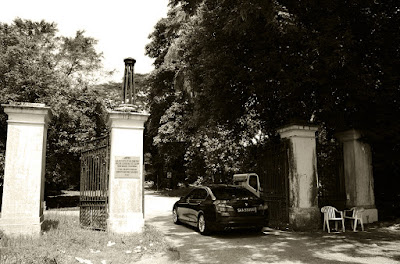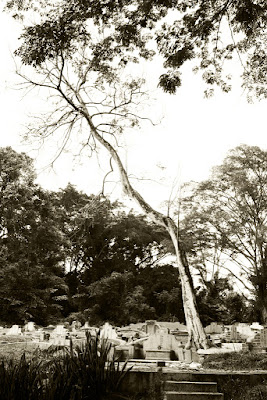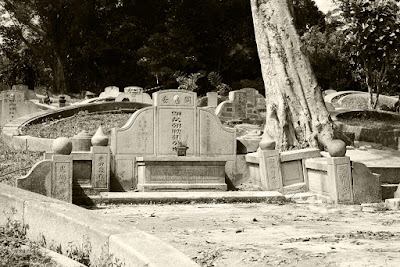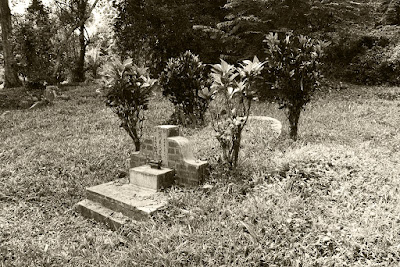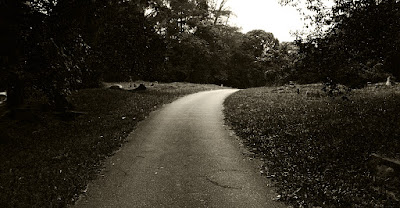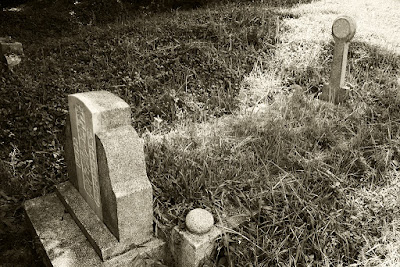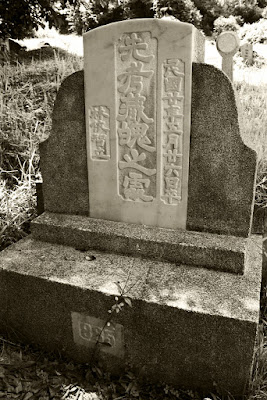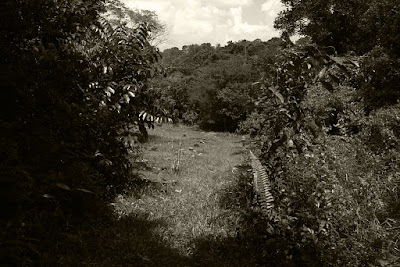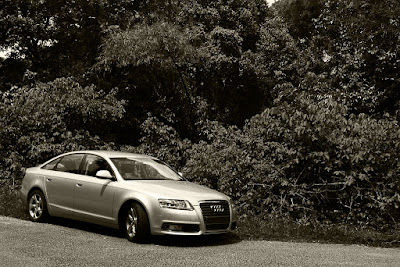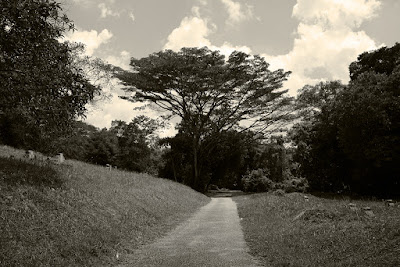Walking with the Lost Soul - Bukit Brown Cemetry
-

Caption : Guided Tour to Bukit Brown Cemetry on 28 April 2013
Credit : Many thanks to Ms Jenny and her husband from the SOS Bukit Brown for guilding us around Bukit Brown Cemetry free of charge and my friend Ananda for organising the trip.
It is not my intention to put up the photos of the tombstone without the consents from the deceased relatives but these are great men and women from the past and that some of these are already printed on the press and blogs such as SOS Save Bukit Brown and Singapore Heritage Bukit Brown.
Also all the while, I had great interest in the YIN fengshui 阴宅and this trip gave me an opportunity to see some of the great work of the fengshui masters of the old.
-
i going to ubin on wednesday
so that i could see the last of it before its gone
-

Caption : Main Entrance into Bukit Brown Cemetry
Some 28 years ago, we (the brothers) promised my father on his death bed that we will continue to visit his father (my grandfather) grave in Bukit Brown Cemetry every Cheng Beng (one of the chinese 24 seasonal calender). Therefore I'm pleased at least with myself for I've yet to fail keeping that promised.
However, years after years, I've hastily visited the grave and hastily leave without really looking around. So, it's a real pleasure to finally be able to walk all round the Bukit Brown cemetry and guided with all the explaination and stories of Bukit Brown.
-

Caption : Begining of the destruction to Bukit Brown Cemetry
News of the exhuming of Bukit Brown Cemetry along with Seh Ong Cemetry and Coffee Hill (kopi sua) had all along been on the government plans but finally in September 2011, it had been confirmed exhumation will begin after April 2013 for the new 8 lnes highway that will cut across the cemetries.
With the calls from the nature lovers and the heritage group, the government finally relented and cut down the numbers of tombstones that will be exhumed. This comes as a good news for me especially when I discovered that my ancestor's tomb will be spared for now. Not that my ancestor had a great fengshui location but that as a conventional Chinese, it is not desirable to have our ancestors restiing place disturbed.
-
Here's a little history of Bukit Brown Municipal Cementry. Bukit Brown Cementry long exist before but it was formally aquired by the British government in 1922 to serve the burial need of the large Chinese communities. The original plot of land belongs to the Hokkien Ong clans.
Bukit Brown is the resting place of many well known prominent Chinese such as Mdm Eu Kong, mother of Eu Tong Sen, Tan Lark Sye, a philantropist and a rubber magnate, Ong Sam Leong, a renowned entrepruner, Mrs Lim Nee Soon, Lim Chong Pang named after Chong Pang village to name a few.
Bukit Brown Cemetry was finally closed in 1973 with about 100,000 tombs by then.
-
Plans of the overall cemetries that may not live to see 2030 when the population reached 6,900,000
PAP will be gone by 2030.
-
wn

Caption : Valley with overgrown secondary forest, home to endangered birds, monkeys and insects
All the haste had let me lose out on some of the wonder of Bukit Brown Cemetry. The orchestra of the cicadas, the 15 endangered spices of birds, the huge bird nest ferns, home to the fruit bats hanging upside down.

Caption : Huge rainforest tree overgrown with birdnest ferns
Bukit Brown is now a secondary forest providing shades and shelter of many of these wild animals such as macaques and kingfishers. There are plenty of fruit trees and fishes from the little stream that keep the eco-system going.

Captions : Macaques feasting on leftover Cheng Beng offerings
-
What's the use of remembering the past when future is not longer part of the past?
-
Such is the rhetorical nature of that question that I might as well be asking what would then be the point of asking that?
-
Originally posted by SevenEleven:

Caption : Valley with overgrown secondary forest, home to endangered birds, squirrels, monkeys and insects
This forestry is worth preserving.
In currently fashionable postmodernist trends, it is usualto either deny that reality exists apart from our knowledge (usually understood as our linguistic representations) of it or todeny that our knowledge in any way 'reflects' the world as it exists in and of itself.
The phenomenal world is real in so far as it is the absoluteTruth or Reality as perceived by the relative human mind in accordance with its natural structure or phenomenal attributes.But it is false and unreal if taken as something ultimate andself-subsistent ( as some cosmological models like theSteady State or Cyclic Universe ).
As T. Isutzu once wrote : A true metaphysician worthy of the name is one who is capable of witnessing in everysingle thing in the world the underlying Reality of which thephenomenal form is but a self-manifestation and self-determination .
-
Originally posted by Clivebenss:
What's the use of remembering the past when future is not longer part of the past?
it's only a matter of delaying the process. With the motion passed on the white paper, this place is earmarked for more new development.
-
Originally posted by SevenEleven:
it's only a matter of delaying the process. With the motion passed on the white paper, this place is earmarked for more new development.
new migrants are more important than heritage.
nothing gonna stop the gdp growth.
-

Caption : Random tombstones that are well maintained
These typical tombstone with the horseshoe heads and a drainage system are typical Hokkien-styled tombs. Chinese businessman tombs have "fu shen" (�神) stones guarding the tombs while ordinary Chinese have "hou tu" (�土) as their guarding angel on the left of the tomb.

Caption : A typical teochew styled tombstone
The above is a teochew styled tombstone. How can you tell that? Well, if you notice, the wording on the tombstone is both red and green is a tell tale sign the deceased is of teochew origin. Another tell tale sign is the 2 halves of the gourds on the left and right of the stone inscription. Of course you can confirm it if you read the inscriptions. Normally the top of the stone will tell you his origin (hometown) while the left will tell you when he passed on.The right will normally be the name of his descendants. You can also tell his affiliation to whichever Chinese dynasty or party. A “清” will tell you he's affilcated to the Qing dynasty and a "民国" will tell you he's affilicated to the Sun Yet Sen government.
-

Caption : Random tombstones that are well maintained
These typical tombstone with the horseshoe heads and a drainage system are typical Hokkien-styled tombs. Chinese businessman tombs have "fu shen" stones guarding the tombs while ordinary Chinese have "hou tu" as their guarding angel on the left of the tomb.

Caption : Random tombstone without proper allocation
These are normally affilicated to the Qing dynasty or are hastily buried during the World War II during the Japanese occupation. The number on the pole you see on the pictures are those that will be affected by the exhumation exercise for the new 8 lanes super highway.
-

Caption : A beautiful guardian animal on the tombstone
It's a pity that some of these beautiful stone carving will be demolished along with the tomb. This is the one and only pair of bird carving in the 100,000 odds tombs. Other tombs are completed with a pair of boy and girl guardians and even fruits of the four seasons such as pumkins and peaches

Caption : Other exotic animals and angel carving on the tomb
Normally the more carving the tombstone have can tell you about the wealth of the deceased. Another would be the location of the tombstone. Those that sits on top of the hills will tell you that they are rich and those on the valley are of the peasants. This would coinside with the chinese beliefs that the tomb should "sit on the mountain face the sea"
-
don't worry, my old relatives have their parent's grave there told me the big big shot by certain surname have ancestors graves there thus I don't see this will be totally gone. This certain big shot believes in feng shui.
-
This page is delicated to the tombs of the famous Chinese in Bukit Brown Cemetry

Caption : The tombstone of the ancestor of the Lee Family
The tomb above is Lee Yun Long, the ancestor of our first Prime Minster of independent Singapore. He died in 1942 as indicated on the right of the inscription in the 31st year of China independence. On the left of inscription mark the date of his death in Japanese koki calender. According to our guide, he was working with the Japanese before his death. This tomb was erected by his son Lee Chin Nam who is the father of Mr Lee Kun Yew. Unfortunately this tomb looked like no one had visited it given the condition of it.

Caption : The 72nd descendent of Confucious
The above tomb is Mrs Kung Tiang Siong. Her brother is Kung Tiang Siong and her maiden name is Lie Sio Neo. She was the first Chinese girl student at the Methodist Girl School which probably were the school of the British girls. She died in the year 1926. Today, the Kung clans has reached it 81st generation with more the 3,000,000 descendents worldwide.
-
actually , it is kind of morbid to visit cementary. I scare scare
-

Caption: Tombstone of Ong Sam Leong a renowned entrepruner
This is one of the grandest tombstone in Bukit Brown Cemetry. It was said that the site used to be the size of 10 HDB flats and sits right at the top of the hill. It is so beautifully crafted and I'm very sure that it is the work of some great fengshui masters of the old. I'll attempt to read this fengshui after giving some descriptions of this site.
(Disclaimer: I'm not a professional geomancer and thus the interpretation is solely my own views)
This site fit the 阴宅 to the T. I took the bearing of this site with a compass and it pointed to the west. That mean it is sitting on the West and facing the East. (�西�东) It is believed that facing the East would see the sun rise(阳)while sitting on the West not seeing the sun set. Furthermore sitting on the hilltop overlooking the valley fit the description (�山�海). It command an unobstructed scenic surrounding as it is suitated on the highest of all the hill in Bukit Brown.

Caption : Ong Sam Leong tomb located on the blue colour hill in the centre
As indicated in the picture above, there's 2 other hill on the right (red) and left (blue), it also fit the description left the green dragon, right the white tiger, front the red pheonix and back the black tortoise. (å·¦é�’龙,å�³ç™½è™Žï¼Œ å‰�朱雀,å�ŽçŽ„æ¦). The tomb has its back on the mountain (å�ŽçŽ„æ¦), an unblock front overlooking the valley (å‰�朱雀) with a short hill to it right (å�³ç™½è™Žï¼‰ and a longer range to its left (左é�’é¾™).
-

Caption: A pair of lions and a skih guards gracing the ground
2 huge stone lions stood guarding the flat ground as you approach the tomb and stand guard include 2 tall skih guard which represent loyalty stood in attention. if you look carefully, in between the guard and the lion ia a groove with grey stone slab on it. On the left side are carving of dragon claws and on the right are the carving of the tiger claws representing the green dragon and white tiger. It's a (å·¦é�’龙,å�³ç™½è™Žï¼Œ å‰�朱雀,å�ŽçŽ„æ¦) (shape of the tomb) within a (å·¦é�’龙,å�³ç™½è™Žï¼Œ å‰�朱雀,å�ŽçŽ„æ¦) (shape of the terrain)

Caption : A guardian fish shaped spout used to slowdown the flow of water
Right in front of the tomb, there is a long trenchs that collect the water from the rain flowing down. The guide told us that it was used as a pond to rear carps in the old days. Although water represents wealth, stagnant water or fast flowing water is not good in fengshui termology. I strongly believed that the fengshui water theory had been applied on this site as the water is all round the tomb. Therefore it can be seen that thought and effort had been put in place.

Caption: Higher relives carving depicts stories like the 24 filial piety
Stories of the chinese idealogy are carved all over the tombstone to beautify it. For example, the above story tell of a son who would always be at her mother side whenever there are thunder and lightning. Even after the demise of her mother, he would still go to her grave to keep her company whenever there are thunder and lightning. If you look into the picture there's a man hugging the tomb and above him is the god of thunder and lightning.
-

Caption : This would probably the the most popular of all as it appears on the newspaper and television media most often
This is the tomb of 玉龙周 a very famous TCM doctor of his time. He was said to have many students in China. From the design of the tomb, he was a pro-Sun Yat Sen government. A compass reading of this tomb is due North, thus fitting the bill "sit North, face South" (�北��)Sitting position of a 阳宅. Also it is sitting on the hill fitting �山�海。 If you are asking where's the sea, the road infront can be represented as sea in fengshui termology. Perhap that explains the popularity of his tomb.
Also this tomb help me locate my ancestor tomb right infront of this amongst the pauper burial ground.
-
This ends my adventure of WALKING WITH THE LOST SOUL - BUKIT BROWN CEMETRY as we headed towards Adam Road Hawker Centre for the famous Nasi Lemak.
-
It was a nice 15/10/2011 (Saturday) morning when the bunch of us embarked on a guided touraround the cemtery at Bukit Brown, which was also known as Kopi Sua (Coffee Hill). As would happen, we sorely underestimated the ferocity of the sun and ran out of water early and the rest of the trip was spent trying to stay alive in the heat. Nonetheless it was worth a trip anytime though I daresay we would be better prepared if there was any next time.
As they say, and myself too a few times already in this blog, a picture says a thousand words, so here goes:
The gate that marked the entrance of Bukit Brown Municipal Cemetery, though it was hard to ignore the sprawling graves everywhere, even outside of the supposed boundary.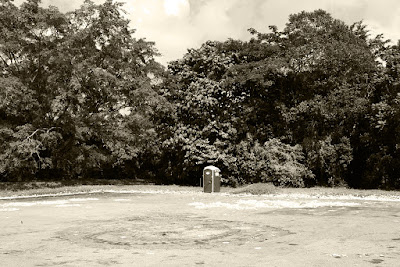
A few minutes walk after walking through the gates, there was a huge open space. Its immensity can be seen from how small the solitary portable toilet appeared to be here. It would also appear that offerings were burnt on a large scale here as can be seen from the scorch marks on the ground.
It would be hard for me to post every picture (with edits). In the same vein, though I initially wanted to group my pictures together as I post, I decided that chronological order would be better and the theme can always be pointed out again in any case. Here, a tree can be seen growing out of the compound of a grave. This was no young tree and we initially thought that it was borne by nature as a seed to take root there.
A closer look revealed that the tree appeared to have been planted purposefully there. Talk about wanting to stand out indeed. It was rather attention-drawing to say the least. The workmanship of the graves were astounding: the tree root had succeeded in shifting the stones, but not break them.
Rows upon rows of graves. This section appeared to be more orderly and uniform in comparison to the rest of the cemetery.
The usual Chinese guardian, one of two stone lions standing guard at the tomb.
If you wished to beautify a tomb without having to spend a bomb and still make it stand out, this method worked well too. Small colourful bush/shrubs were the norm while the large tree in the first couple of pictures was the exception.
We plodded along the road further. Of course, as the name suggested, this place was hilly as can be seen in the sudden drop in this picture. Besides good fengshui, hill burials served a practical purpose of affording better drainage as well.
And the road winds too.
The tombstones weren't all old and uniform too. This one was fairly recent and decidedly less "Chinese". I hadn't realised then that the stone was smooth enough to cast a reflection. Now I do. Unlike the barely visible grave on the left, it was clear that this one wasn't forgotten.
This one proved more perplexing. Nobody quite got what was housed beneath the stone. It could even be a memorial of sorts. What made it even more interesting was the marker a human length behind the tombstone. What was the significance of the marker?
There was even a number engraved on the base of the tombstone. Nobody could understand the inscriptions either, which made it even more of an enigma. We do not know all of our history and yet we are bent on destroying them. This would most certainly be a rather regrettable point.
A quick look through the undergrowth where we were climbing. It was clear that someone had hacked this route through the undergrowth for people to reach the graves higher up the hill.
A random shot to take advantage of the strong contrast afforded by a parked Audi's silver paint against the dark green vegetation.
It is not often in Little Red Dot that one gets to enjoy such a scenery. How much would we really stand to lose in developing this plot of land? Perhaps we know best only after we lose it.
I was surprised to find a flight of stairs leading from the road to......what appeared to be nowhere. Yet it looked like it wanted to lead us to something and we followed through.
And this was what we found at the base of the tree at the end of the flight of stairs: The resting place of Mr Lim Chong Pang, a famous businessman whose namesake evokes thoughts of delicious hawker food. For such a celebrated person, it was perhaps surprising that it was less grand that expected, and appeared to have been less taken care of as would have been expected.
The road seemed to go on forever. That was particularly true in the searing heat.
-
Thanks for the description, 711. I was wowed by OSL's tomb when I made my own visit some months back.

